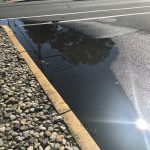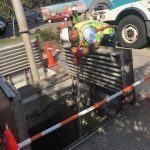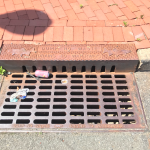New Jersey Future Blog
Clean Water in the Garden State: Reflecting on 50 years of Progress and Challenges
October 18th, 2022 by Lindsey Sigmund
This year marks the 50th anniversary of the monumental piece of legislation known as the Clean Water Act (CWA). The CWA plays an important role in cleaning water pollution and protecting healthy waterways in the State of New Jersey for drinking water supply, healthy habitat for fish and wildlife, and economic and recreational activity. As we look ahead, we also acknowledge the work that still must be done to ensure that the CWA’s legacy is lived out in full.
In response to growing concerns over the quality of our nation’s bodies of water, the federal government passed the CWA in 1972, an amended version of the Federal Water Pollution Control Act of 1948. The CWA established the structure for regulating the discharge of pollutants into the waters of the United States and regulated water quality standards of surface waters and wetlands. Prior to the passage of this landmark legislation, there was minimal regulation of what could be dumped into our waterways, which led to polluted rivers and lakes, contaminating many sources of drinking water and causing serious impacts for human health. Thankfully, today, it is unlawful for any pollutant to be discharged from a point source into navigable water without obtaining a permit.
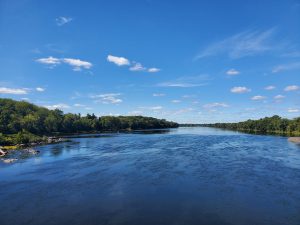
Delaware River, Trenton, NJ, 2022. Photo Credit: Alyssa Zabinski, New Jersey Future
Since the 1970s, a significant volume of pollutants have been better managed, more lakes and rivers are fishable and swimmable, and the overall health of our waterways and wetlands has improved. However, progress has not been linear. Even today as we watch the Sackett v. EPA case unfold in the Supreme Court—where the classification of which bodies of water are considered waters of the United States (WOTUS) and thus can be regulated under the CWA is being determined—it is clear that the specifics of the CWA’s power have been largely contested. Over the past few decades, the Supreme Court and presidential administrations have restricted or reinstated protections for wetlands, streams, and other bodies of water. While battles may ensue on the federal level, New Jersey has been fairly consistent, going beyond minimum federal standards to protect the quality of our water resources.
One of the benefits of the CWA was the establishment of shared responsibility between the federal government and the states for regulation of waterways. For example, the CWA includes the option for states to assume the management of the Section 404 permit program to regulate dredge or fill material for certain waters not preempted by the U.S. Army Corps of Engineers. New Jersey is one of the few states that formally manage the permit program and acts as an example for other states working through clean water regulatory issues. While CWA enforcement is shared by the EPA and states, states have primary responsibility of ensuring compliance is achieved and programs are tailored to the unique needs of their communities.
A prime example of New Jersey’s leadership around clean water is the work of late Governor James Florio. As a congressman in the 1970s, Florio fought for the passage of the CWA. As governor, Florio was responsible for the Clean Water Enforcement Act (CWEA) of 1990, which solidified New Jersey’s commitment to water quality protections. The CWEA requires the New Jersey Department of Environmental Protection (NJDEP) to inspect permitted facilities and municipal treatment works annually. The CWEA is an excellent example of the reinforcement and reinstatement of the CWA on the state level.
The passage of the CWA has improved the quality of New Jersey’s waterways through regulating point source pollution, but nonpoint source pollution is still a looming concern. Non-point source pollution is caused by rainfall or snowmelt traveling over impervious cover, such as roads or roofs, carrying pollutants into storm inlets or directly into waterways. With a highly developed state such as New Jersey, retrofitting our impervious cover to include best management practices such as green infrastructure to decrease nonpoint source pollution and improve water quality and reduce flooding, is paramount.
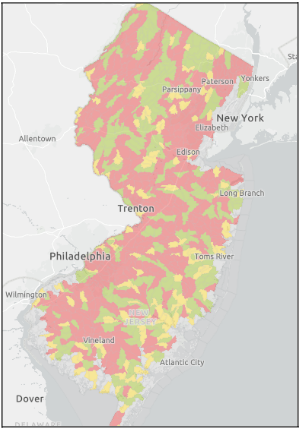
Impared streams in New Jersey shown in red (NJ Water Risk Equity Map, Rutgers University, Jersey Water Works)
In 2020 NJDEP published a new set of stormwater management rules that require the use of green infrastructure for new development. Prior to the rule change going into effect March of 2021, New Jersey Future, along with our partners, advocated for strengthening said rules to capture additional projects that increase impervious cover in order to better manage stormwater runoff across the state. With the reinforcement of sound research and public support, New Jersey improved its stormwater management rules and further increased protections of our water resources.
To improve current conditions, NJDEP anticipates approving a new and improved Tier A Municipal Separate Storm Sewer (MS4) permit early next year. The draft permit sets forth watershed level planning requirements for municipalities to address stormwater runoff. In response to the draft permit issued in July 2022, New Jersey Future issued comments and provided testimony to emphasize the need for faster implementation timelines and additional technical assistance and guidance from NJDEP to ensure permittees can reach compliance.
Sometimes rule updates, permitting updates, and other statewide initiatives are not always voluntary; at times the federal government gets involved. Through the National Combined Sewer Overflow (CSO) Policy, the Environmental Protection Agency (EPA) issued requirements for all states with combined sewer systems to have their municipalities mitigate their combined sewer overflows through projects outlined in a Long Term Control Plan (LTCP). The LTCP outlines the most cost-effective manner to regulate CSOs to meet water quality standards. For the past few years, the Sewage Free Streets and Rivers campaign, staffed by New Jersey Future, has brought together grassroots organizations and residents of environmental justice communities with combined sewer systems to advocate for compliant LTCPs and robust community engagement around the planned water infrastructure projects. The LTCPs have been submitted to NJDEP, however these submittals have not been formally approved. The contents of these plans and their implementation will drive major infrastructure overhauls in 21 municipalities that currently experience overflow events that degrade their waterways. The results should drastically improve water quality, however the issue of funding and who foots the bill is ever-present.
In addition to permitting, NJDEP provides funding for local stormwater management projects through the 319(h) provision of the CWA. Earlier this year, NJDEP awarded $9.4 million in grants to municipalities, nonprofits, universities and others to fund local stormwater management projects. Municipalities including Newark, Trenton, and Jersey City received funding for tree plantings, green infrastructure, and other public improvements to manage stormwater to restore and protect water quality in their watersheds. Despite these funding sources, there is still a significant gap in funding, especially for overburdened communities. With the passage of the American Rescue Plan (ARP) in 2021, New Jersey allocated $300 million of its relief package to fund critical water infrastructure. However, additional outreach and technical assistance is needed to ensure that this infrastructure funding reaches overburdened communities. It is imperative that green infrastructure and other water infrastructure improvements are implemented in New Jersey’s overburdened communities, where improved management of our contaminated water legacy will make for healthier communities.
While great strides have been made in the past half of a century, many of our state’s waterways are still considered impaired, as indicated in the map above. Many of these waterways are contaminated from historic industrial uses, unregulated non-point source pollution, and mismanaged water and sewer infrastructure. All of these contributing factors are further exacerbated by climate change and related increasing temperatures and shifting precipitation patterns. As New Jersey grapples with our industrial past, surface and drinking water impairments, climate change, and environmental injustices, there is still a great need to progress further toward the original intent of the Clean Water Act. Here’s to the next 50 years of working toward fishable and swimmable waters for everyone in the Garden State!
Related Posts
Tags: 50th Anniversary Clean Water Act, clean water, Clean Water Act, Combined Sewer Overflow (CSO), green infrastructure, local waterways, pollution, Stormwater, Water, water infrastructure, water pollution, waterways


